 |
 |
 |
| |
The Association Between HCV And Comorbid
Conditions In 2 Large Patient Cohorts
|
| |
| |
from Jules: this is in part why HCV treatment rates are declining: "Continua from both institutions revealed large gaps between HCV RNA+ diagnoses and HCV treatment. ....Care continua analyses suggest wide variability in screening and follow up testing between institutions and populations, though both institutions treated fewer than 5% of the estimated numbers of patients living with chronic HCV who were newly enrolled in care from 2008-2014"
+ Long Term Healthcare Costs of Not Treating Drug Users for HCV
it is not news that HCV-infected have higher rates of extra-hepatic manifestations of diseases which in HIV they call comorbidities. Many studies - see link below - report increased cardiovascular disease, kidney disease, perhaps diabetes, worsened cognitive impairment, cancers/lymphoma and also mixed cryoglobulinemia (MC). There have also been studies finding SVR can for some reduce the impact of these diseases. And this study just below found similarly to other research that HCV in HIV+ increases inflammation & immune activation thusly increasing the risk for comorbidities, and this study also found active IDU and those who recently stopped had higher immune activation & inflammation markers including sCD14 and CRP. These findings reflect the increased risk for cardiovascular disease for current & former IDUs. Studies have found cocaine use associated with cardiovascular disease. The remaining question is for IDUs who stopped 1-2-30 years ago - is there risk eliminated? I think the risk is reduced but the damage may have been done & increased risk persists. By denying HCV treatment to drug users the long term costs for care & to the healthcare system & medicaid & medicare will increase quite a lot. This point gets lost in discussion of access to HCV treatment today, that if we treated IDUs & substance abusers the long term healthcare costs for these groups would decline. Clearly both State & federal top official decision makers like the White House & Congress are mostly ignoring the needs of addressing HCV. Very small pockets incremental progress can be seen but in the big picture very little has been done to address HCV in NYS, other States and at the very highest on the Federal level.
CROI/2016: Understanding the Relative Contributions of IDU and HCV on Systemic Immune Activation HCV should be aggressively treated in current IDUs even more if HIV and/or HCV positive - (04/4/16)
Reported at AASLD was this study showing improved renal function with SVR- AASLD: The Impact of Hepatitis C Viral Cure on Progression of Renal Disease - (11/14/16)
AASLD: Chronic Hepatitis C Virus Infection and Cancer Risks: A Population-Based Cohort Study - (11/14/16)
Eradication of HCV and non-liver-related non-AIDS-related events
(CVD/diabetes/kidney/cancers) in HIV/HCV coinfection - (02/01/17)
---------------
Depression, Coronary Artery Disease, Kidney Disease More Frequent With HCV
Conference on Retroviruses and Opportunistic Infections (CROI), February 13-16, 2017, Seattle
Mark Mascolini
Besides cirrhosis and liver cancer, people with chronic HCV infection in two large Colorado cohorts had higher rates of depression, coronary artery disease, and chronic kidney disease [1]. In adjusted analyses, odds of depression and death were higher with than without chronic HCV.
The impact of HCV on liver health is well studied, but the impact of the hepatitis virus on nonliver conditions remains poorly understood. To learn more about potential associations between HCV and nonliver conditions, researchers examined electronic medical records of Kaiser Permanente Colorado and Denver Health. They looked for evidence of HCV antibody testing from 2008 through 2014, HCV RNA testing and HCV treatment from 2008 through 2015, and sustained virologic response through 2016. The investigators used logistic regression adjusted for age, gender, race, insurance type, obesity, and tobacco and alcohol use to identify associations between chronic HCV (detectable HCV RNA) and comorbid conditions or death.
Among people who began care at Kaiser Permanente or Denver Health from 2008 through 2014, 7.2% at Kaiser and 5.5% at Denver Health got tested for HCV. Using CDC data, the researchers estimated that these centers treated fewer than 5% of people with chronic HCV who entered care in 2008-2014.
The comorbidity analysis involved 1620 people with chronic HCV versus 78,178 without chronic HCV (HCV antibody negative or antibody positive and RNA negative) at Kaiser Permanente and 1859 with chronic HCV versus 26,831 without chronic HCV at Denver Health. In both the Kaiser and Denver groups, significantly higher proportions with HCV were older (medians 54 vs 41 and 47 vs 40, P < 0.0001), were men (61% vs 45% and 67% vs 50%, P < 0.0001), had a history of alcohol abuse (6% vs 1% and 66% vs 30%, P < 0.0001), currently used tobacco (40% vs 16% and 75% vs 43%, P < 0.0001), and used illicit drugs (8% vs 4% and 58% vs 22%, P < 0.0001).
Cirrhosis, liver cancer, depression, coronary artery disease, chronic kidney disease, and death almost always proved more frequent in people with than without chronic HCV at both Kaiser Permanente (KP) and Denver Health (DH):
With versus without chronic HCV
-- Cirrhosis: KP 6% vs 1%, DH 25% vs 5%
-- Liver cancer: KP 3% vs 0%, DH 3% vs 0%
-- Depression: KP 6% vs 2%, DH 54% vs 41%
-- Coronary artery disease: KP 2% vs 1%,DH 2% vs 2%
-- Chronic kidney disease: KP 4% vs 2%, DH 11% vs 8%
-- Death: KP 11% vs 4%, DH 13% vs 5%
Adjusted analyses identified independent associations between chronic HCV and several of these outcomes, at the following adjusted odds ratios (aOR) and 95% confidence intervals (CI):
-- Cirrhosis (at KP): aOR 10.2, 95% CI 7.7 to 13.32
-- Cirrhosis (at DH): aOR 3.82, 95% CI 3.33 to 4.37
-- Liver cancer (at KP): aOR 4.44, 95% CI 3.05 to 6.46
-- Liver cancer (at DH): aOR 3.23, 95% CI 2.21 to 4.73
-- Depression (at KP): aOR 1.79, 95% CI 1.35 to 2.38
-- Depression (at DH): aOR 1.3, 95% CI 1.12 to 1.45
-- Death (at KP): aOR 2.88, 95% CI 2.5 to 3.32
The researchers add that continuum of care data "suggest wide variability in screening and follow-up testing between institutions and populations." They underline the small estimated fraction of people with chronic HCV who began treatment during the study period.
Reference
1. Rowan SE, Durfee J, Tabano DC, et al. The association between HCV and comorbid conditions in 2 large patient cohorts. Conference on Retroviruses and Opportunistic Infections (CROI), February 13-16, 2017, Seattle. Abstract 528.
-------------------
The Association Between HCV And Comorbid Conditions In 2 Large Patient Cohorts
Reported by Jules Levin
CROI 2017 Feb 14-16 Seattle, WA
Sarah E Rowan, MD1, Joshua Durfee1, David C Tabano2, Suzanne Dircksen1, Edward Havranek, MD1, Arthur Davidson, MD1
1Denver Health and Hospital Authority, 2Kaiser Permanente Colorado
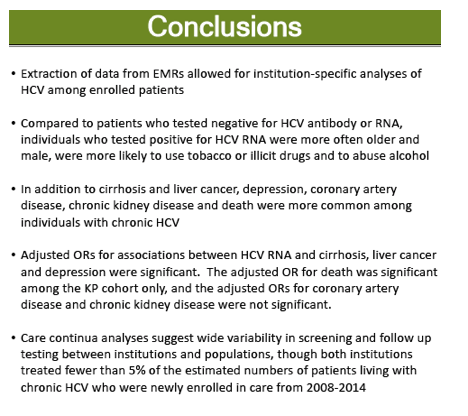

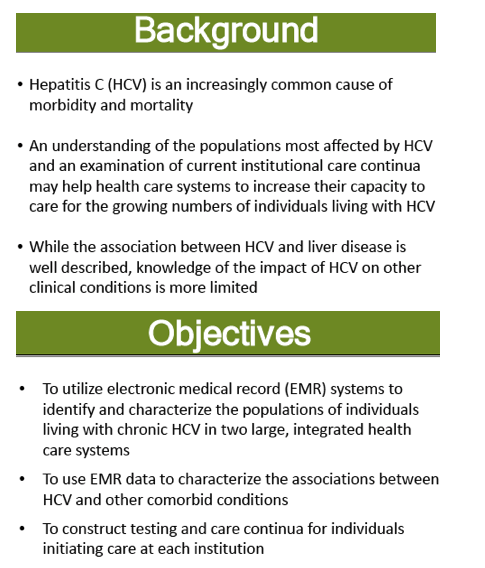

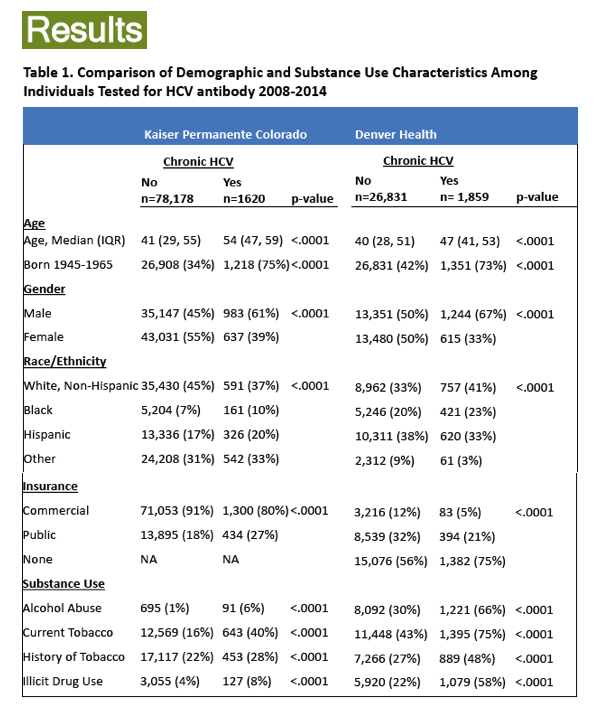
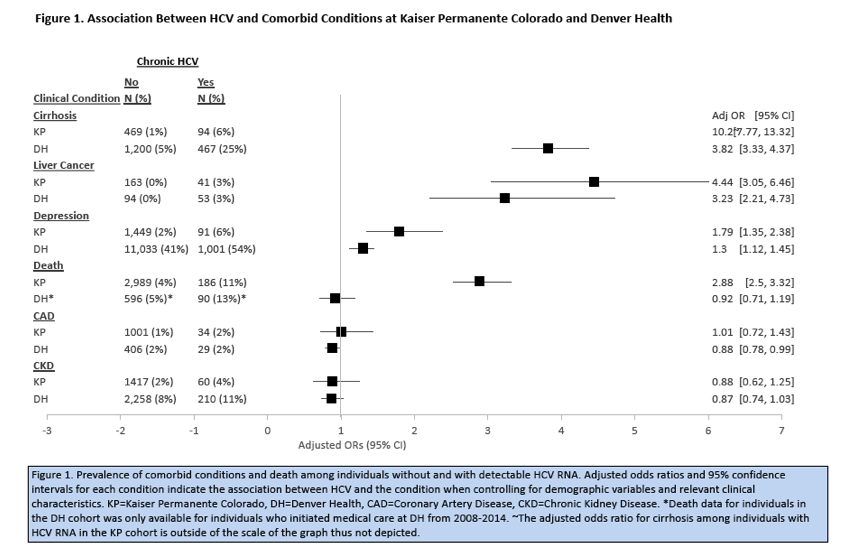
Figures 2 and 3. Of the 358,329 adults who enrolled in care at KP from 2008-2014, 25,696 (7.2%) were tested for HCV. Of the 273,244 adults newly initiating care at DH during the same time frame, 14,968 (5.5%) were tested for HCV. Estimates of numbers of individuals living with chronic HCV were derived by applying U.S. prevalence data to the cohorts of individuals newly enrolling in care at each institution. Percentages of individuals with positive HCV RNA tests among those estimated to be HCV RNA+ ranged from 16% to 31%. Continua from both institutions revealed large gaps between HCV RNA+ diagnoses and HCV treatment.
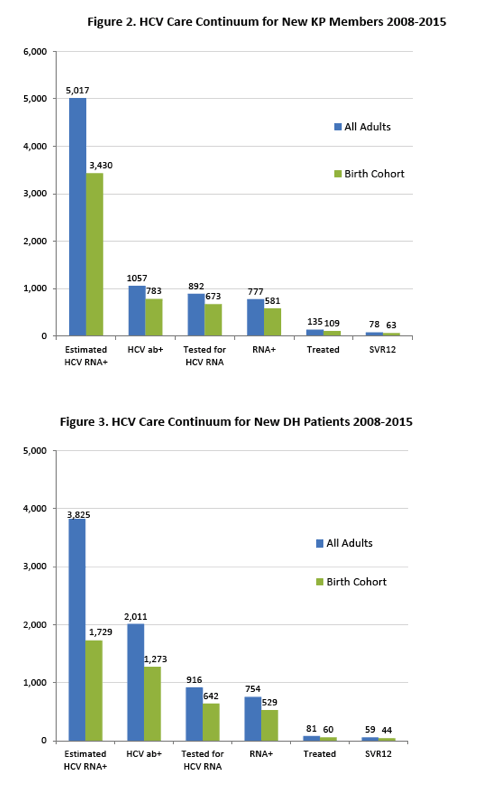
|
| |
|
 |
 |
|
|